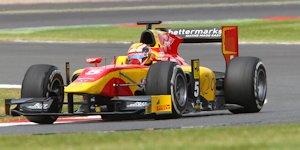 |
|
 |
 |
 |
 |
 |
17/07/14 GP2 Series Round 6, Hockenheim is the next venue for Stefano and Lello.
|
|
|
 |
This weekend it is the turn of Hockenheim in Germany to host the next round of the 2014 GP2 Series and it will mark the halfway point in the season with five rounds completed and five more to come. The last round at Silverstone was largely positive for the Racing Engineering team with Stefano finishing 2nd and 4th in the two races to move up to 5th in the Championship and Lello being fastest in free practice and taking pole position in qualifying but a mechanical problem caused his retirement in the Feature Race and an accident put him out of the Sprint Race.
It is two years since the GP2 cars last raced at Hockenheim and on that occasion Racing Engineering took a 2nd and 4th place in the two races and they will be looking to get both Stefano and Lello on the podium in both races this weekend.
The revised 4.574km Hockenheimring, designed by Hermann Tilke in 2001, no longer has the fast sweeping straights running through the forests that made the old track so intimidating. It now comprises 17 corners, a number of which are relatively tight but it still boasts the famous concrete Stadium section where all the fans gather to watch the racing.
Timetable:
Practice: Fri 18 Jul 2014, 12:00 (GMT+2)
Qualifying Session: Fri 18 Jul 2014, 15:55 (GMT+2)
Race 1: Sat 19 Jul 2014, 15:40 (GMT+2)
Race 2: Sun 20 Jul 2014, 10:35 (GMT+2) |
|
 |
| ©GP2 |
|
 |
| ©Racing Engineering |
|
 |
| ©Racing Engineering |
|
|
 |
 |
Length of lap:
|
4.754 km |
 |
| 2013 best Racing Engineering: |
P3 in Qualifying – P2 in R1 – P4 in R2 |
 |
Tyre Wear:
|
Medium |
 |
Brake Wear:
|
Medium |
 |
Downforce:
|
Medium |
 |
Throttle Average:
|
Wet Race |
 |
Fastest turn:
|
T7 |
 |
Hardest Braking Point:
|
T6 |
 |
Gear shifts per lap:
|
34 |
 |
Top Speed:
|
300 km/h |
 |
| Average Speed (Qualifying) 2013: |
158.297 km/h (wet track) |
 |
| Average Speed (Race) 2013: |
183. 857 km/h (drying track) |
 |
| Pole Position Time 2013: |
1:44.022 (wet track) |
|
|
 |
 |
1. Hockenheim
is a small town in southern central Germany. For most of the year its
population averages little over 20,000. However, on race weekends that figure
soars to well over 100,000.
2. The
Hockenheim Ring is above average when it comes to engine demands, featuring a
higher than average power sensitivity.
3. The curved
parabolica straight is over 1km long, on a par with the longest straight of the
season: Abu Dhabi.
4. Hockenheim
produces one of the highest per kilometre fuel consumption rates of the year.
The strong braking of the hairpins and the twisty infield section increase the
consumption dramatically.
5. This
sinuous nature gives rise to the second lowest average speed over a lap (after
Monaco).
6. Given the
quick changes of direction encountered in the stadium section and through turns
three and four, a stable car is very important.
7. The
circuit features 17 corners -10 right-hand and 7 left-hand corners.
8. Best
places to overtake are the hairpin turn, in front of the Mercedes Arena and the
entry to the motodrom.
9. The right
set-up is a challenge in order find the compromise between downforce and
aerodynamic drag to meet the requirements of the fast straight and the slow
motodrom.
10. Pole position is on
the left-hand side of the track. |
|
|
 |
 |
 |
1. At the
Hockenheim Ring speed is crucial. Whereas in F1 the average speed is 225 km/h
in GP2 it comes down to 183 km/h.
2. F1 drivers
will change gear 46 times per lap against the 34 times a GP2 driver has to
shift gear.
3. Race
distance differs only by two laps: F1 go around the circuit for 67 laps and GP2
do a total of 65 laps over two days- 38 laps in Feature Race and 27 in the
Sprint Race.
4. If we
compare pole position times, a GP2 car is only about 4 seconds slower than a F1
car. Pole position in F1 was set in 2013 at 1:40.904 – Pole position
in GP2 was set in 2013 at 1:44.022. |
|
|
|
 |











